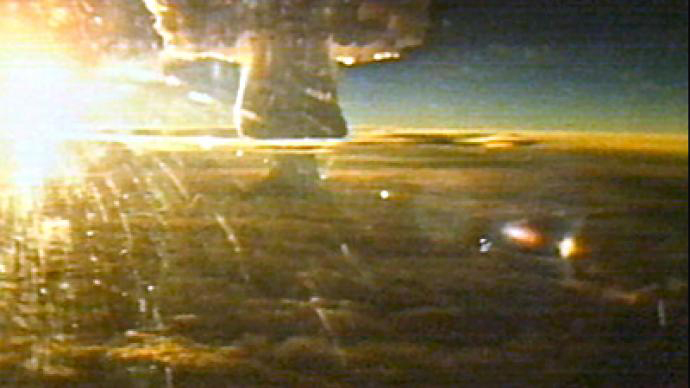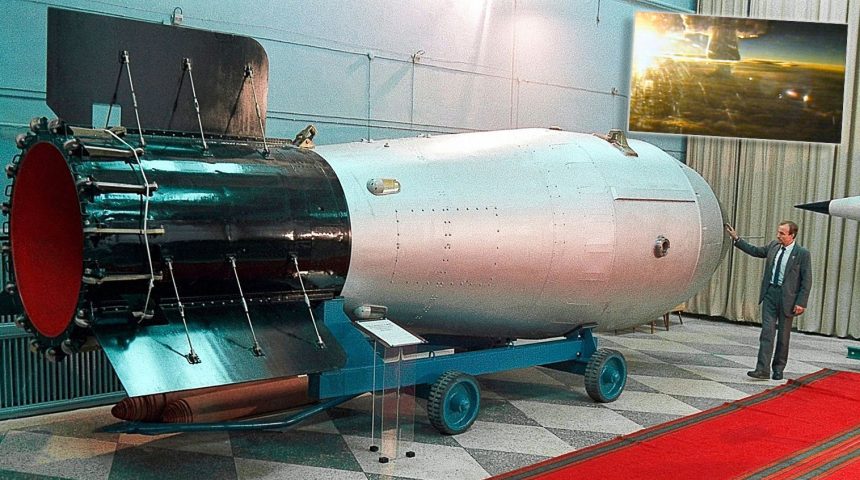Tsar Bomba Was the Largest Hydrogen Bomb Detonated in History, and It Helped End the Cold War.
The titanic 27-ton mega-nuke’s explosion was so massive scientists still disagree about its actual size. Its shockwave was so powerful it circled the earth multiple times. It produced a seething fireball five-miles in diameter that was three times as hot as the sun.
Every building up to 34 miles from the blast- was obliterated. Buildings over a hundred miles away were damaged. And it was an inconceivable 34 times more powerful than the combined blast power of both nuclear weapons used by the U.S. in WWII. This was the unimaginable Soviet doomsday weapon, the “Tsar Bomba” (Soviet name RDS-220) or, by its codename assigned from the U.S. Central Intelligence Agency, “JOE 111”.
Tsar Bomba was detonated over the remote Novya Zemlya area, on a desolate archipelago called Mityushikha Bay test range, test field D-2, Novaya Zemlya Island, that juts into the Barents Sea in the former Soviet Union. It was October 30, 1961. The bomb was dropped from a specially modified Tupolev Tu-95, NATO Codename “Bear”, a unique swept-wing, four-engine turboprop still in service today that flew for the first time in 1952, the same year as America’s B-52 Stratofortress.
Every statistic about Tsar Bomba’s destructive power is difficult to grasp. Even the Soviets were surprised by how powerful the enormous bomb was. Tsar Bomba was the ultimate and most terrifying manifestation of the nuclear era, an age that began with the first nuclear detonation by the U.S. at 5:29 a.m. on July 16, 1945 during the Trinity tests of the Manhattan Project, and continues to this day.
But the tipping point of the balance of terror maintained between the Soviet Union and the United States reached its apogee on the day that Tsar Bomba was tested, and this test underscored the accelerating insanity of nuclear proliferation and the concept of “Mutually Assured Destruction” or “MAD” that kept both sides from pushing the nuclear button.
This year, new film of the only test of Tsar Bomba was released from Russia. The film becomes available as Russia has undergone significant advancement since the collapse of the Soviet Union in 1991. As Russia vaults ahead in a promising new era the country has been increasingly willing to disclose its shadowy past, and the new film of Tsar Bomba underscores how lethal aspects of the Cold War truly became.
But the new Tsar Bomba film raises an interesting question; could a bomb of this size have ever been used by the Soviet Union against the United States? The answer is: maybe.
Tsar Bomba was so enormous, 8m (26ft) long with a diameter of almost 2.6m (7ft) and weighing an unbelievable 54,000 pounds, that it dwarfed America’s largest nuke, the puny 9-megaton B53 air delivered bomb weighing in at “only” 8,850 pounds. Because of its size, it was carried partially outside of its specially-modified Tu-95 called the “Tu-95V”.
A weapon like Tsar Bomba would have been difficult for the Soviet Union to deploy in a first strike nuclear attack on America. U.S. Strategic defenses in the Cold War were built up of concentric rings of distant early warning radars, air defense fighters, long range anti-aircraft missiles with nuclear warheads like the CIM-10C BOMARC and a series of decreasing range nuclear and conventionally armed surface-to-air missiles (SAMS) like the Nike Hercules and Nike Ajax. Some of the U.S. response to a nuclear first strike from the Soviet Union was automated, especially detection of unknown radar contacts approaching the U.S.
While this multi-layer strategic air defense system around America seemed “Fail-Safe” at the time, the reality, revealed publicly only after the Cold War ended, was very different. The U.S. strategic air defense system was, at times, incredibly fallible. The CIM-10C BOMARC system alone was an example of a Cold War air defense system that, on the best of days, would have only been marginally effective. Scholar and author Dr. Christopher J. Bright, Ph.D., pointed out in his research publication, “Continental Defense in the Eisenhower Era” (2010, Palgrave Macmillan), that the BOMARC missile system was only “marginally effective” (Pp.151, “Conclusion”). Other systems shared similar, if not as severe, shortcomings. And while there were overlapping layers of Soviet nuclear bomber defense around the U.S., there were also overlapping shortcomings in those defenses, and the Soviets were guaranteed to have exploited those shortcomings in a first strike on the U.S.
And with a weapon like Tsar Bomba, you can afford to miss many times, you only have to score one or two hits to do inconceivable damage.
Tsar Bomba was likely never intended as an operational air-delivered bomb. One scholarly analysis of the test device says, “A test device, even one that is air-dropped like an operational weapon, is not suitable for normal military stockpiling (although it could be employed as a weapon in an emergency). Entry into a nation’s weapon stockpile requires considerable engineering effort and planning to ensure a satisfactory stockpile lifetime, provision for required maintenance, a variety of safety and security mechanisms, development of suitable delivery techniques and equipment for combat use, development and approval of operational doctrine, institution of a suitable training program, development of a list of suitable targets and operational plans, etc., etc.”

Tsar Bomba was too heavy and degraded the performance of its delivery aircraft too much to be used in an effective surprise first strike. During the single test of the weapon, there was a sense that the crew of the bomber dropping the weapon only had a “50% chance” of escaping its blast effects. In fact, the Tu-95V that did drop the lone test Tsar Bomba was violently rocked by the shock wave, falling over 3,000 feet after losing lift when the bomb’s shockwave hit the aircraft. The recently released video shows the blast as a kind of artificial sunrise that gathers in increasing intensity inside the cockpit of the aircraft with its blinding flash.
Some accounts now suggest Tsar Bomba’s actual yield was 57 megatons, another statistic that is hard to grasp.
Tsar Bomba’s detonation in 1961 is certainly one of several dates during the Cold War that pushed the confrontation between super powers to the brink of actual war. Other incidents included the Cuban Missile Crisis a year after the Tsar Bomba test in October, 1962. Even in the 1980’s, when a little known Soviet officer named Stanislav Yevgrafovich Petrov refused to respond to a spurious incoming missile warning from the Soviet Oko nuclear early-warning system, the world teetered on the fulcrum of nuclear calamity.
But somehow, it never happened. This was despite near-misses on both sides. Today two reproductions of the Tsar Bomba test weapon and its massive braking parachute with five different stages and a main parachute canopy of 5,400 sq. ft. are on display at the Russian Atomic Weapon Museum in the closed nuclear research town of Sarov in Eastern Russia, and the Museum of Nuclear Weapons, All-Russian Research Institute of Technical Physics, at Snezhinsk, another restricted access test facility similar to the American White Sands Missile Range. The area where the Tsar Bomba was tested remains largely off limits, and would be difficult to get to even if it were open to the public. There are some wildlife tour companies that occasionally visit the area south of the test site to photograph polar bears, but they do not enter the area where the Tsar Bomba was detonated.
As time accelerates away from the date of the single Tsar Bomba test, its memory needs to be preserved. The study of Tsar Bomba is one of the best manifestations of the famous George Santayana quote, “Those who do not remember the past are condemned to repeat it.”









